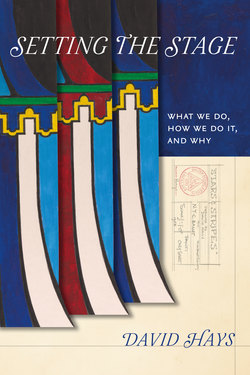Читать книгу Setting the Stage - David Hays - Страница 15
На сайте Литреса книга снята с продажи.
ОглавлениеCHAPTER SEVEN
Boston Again, and Tanglewood
WHILE I WAS at Green Mansions, friends from the Brattle phoned. Would I come to Boston and be a teaching fellow at a new theatre department at Boston University? I would earn a salary and get a master’s degree at the end of one year. The faculty would be Sarah Caldwell, Horace Armistead, Ray Sovey, Elliot Norton, and David Pressman. Add the excitement of a new venture. Of course I went.
I ran student crews, supervised the refurbishment of Sarah Orne Jewett’s old theater, and designed and painted. I found an apartment near Charles Street station, and when Leonora joined me, she participated in all the programs. She became pregnant, and that became suddenly apparent as she was performing Laura in THE GLASS MENAGERIE.
That summer, I designed at Tanglewood, working on, among other works, ZAIDE for Sarah Caldwell. This is a short, unfinished opera by Mozart, and I set it in an Asian garden. A simple projector threw an image of clouds on the set’s cyclorama. The projector sat on the stage floor behind the garden wall and, forgetting all warnings, the tenor sat in front of the projector, waiting for his entrance. His sharp image, as he picked his nose, was thirty feet high in the sky.
Tanglewood’s opera department at that time was led by Boris Goldovsky and Sarah Caldwell. They were brilliant artists, and I recall some amusing conversations. A singer, after auditioning, asked, “Suggestions, sir?” Boris: “Zip your fly.” A patron complained, “Mr. Goldovsky, opera is so fake. The diva is dying, but is able to ruminate at length and at full volume.” The maestro responded, “Why, you are so ungrateful! You are not interested in her final thoughts? And you think she should sing them so softly you can’t hear them?”
WHAT I LEARNED
Horace Armistead and Ray Sovey were superb teachers, and it was instructive to make up the new rules for an academic department as we went along. Stupid ones: there should be separate faculty toilets. Wiser ones: how much individual attention to give to lagging students.
As the stage renovation supervisor, I learned that dust does not stop growing after a height of one inch.
Check the lighting booth. There is probably a graduate student living in it.
Some performers, whatever their gifts onstage, don’t have common sense backstage. Part of a designer’s job, though it is usually handed over to the stage manager, is to protect the actors from tripping over cables, strolling absentmindedly onto the stage, or picking their noses in the virtuosic manner described above.
Explain, explain, explain. You don’t want a director saying to you — despite showing him drawings, plans, and even a model —“David, you never told me the platforms were raised!” (Yes, that happened; you can’t make that up.) A similar story. There’s an old joke: “Can we have funnier lights?” That was actually said to me! I hope it’s never said to you.
Now a sad story. Sarah Caldwell did not like the orchestra to be seen. In one of the operas, based on O’Neill’s THE ROPE, we stretched the floor cloth out over the pit, leaving a small hole for Sarah’s head at the conductor’s position. You could not see where the stage ended and the pit cover began — it was the same canvas. A film crew arrived to scope out the setup, and the director walked out onto the stretched cloth. Our warning shouts were too late. He made it out about six feet and fell with a cry through the tearing canvas into the deep pit. He was falling fast when his knee hit a music stand, and he lay screaming on the floor.
He should have sued, and he did. I wasn’t blamed and wasn’t involved in the suit, and I don’t know the outcome, but I doubt if the unfortunate man ever walked normally again.
There is a point that always comes to me when I remember this misery. Safety of course. A fence, rope, or chain. But also this: looking down at the man through the hole in the canvas, I saw his brown and white tasseled golf-style shoes, highlighting the contrast of his debonair outfit to his writhing pain. It is still vivid to me; it knots my gut. The stark lesson illuminates the essence of much of our work: contrast.
EXERCISE
Learn to print attractively and clearly — all of you. In London, a friend of Roger’s taught me. Letters should be the same height, and don’t let your sentences droop. The main trick is to find a slant you prefer for the letters: straight up, angled, or even tilted backwards. (This is easy to maintain for letters with a vertical spine, like L or K, but harder for letters like A or O.)
